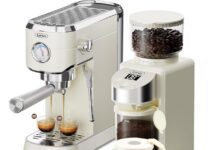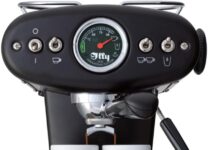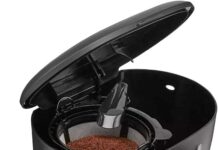If you’re a coffee lover like us, then you know that the quest for the perfect cup of joe is never-ending. And when it comes to making coffee at home, one name consistently stands out: Bialetti. But here’s the catch – their 3-cup Bialetti is a bit misleading. You might think it would yield three cups of coffee, but that couldn’t be further from the truth. In this article, we’re going to unravel the mystery and finally answer the burning question: How many cups does a 3-cup Bialetti actually make? Get ready to sip on some surprising facts!
This image is property of Amazon.com.
Understanding the Bialetti Moka Pot
The Bialetti Moka Pot is a classic stovetop coffee maker that has been a staple in many households for decades. It is a versatile and easy-to-use device that brews a strong and flavorful cup of coffee, similar to espresso. Whether you are a coffee enthusiast or simply someone who enjoys a good cup of joe, understanding how the Bialetti Moka Pot works and how to maximize its potential is essential.
What is a Bialetti Moka Pot?
The Bialetti Moka Pot, also known as a stovetop espresso maker, is a coffee brewing device invented by Alfonso Bialetti in 1933. It consists of three main parts – a bottom chamber for water, a middle funnel-shaped filter basket for coffee grounds, and a top chamber to collect the brewed coffee. The Moka Pot utilizes steam pressure to extract the coffee’s flavors and oils, resulting in a strong and aromatic beverage.
How does it work?
Using a Bialetti Moka Pot is a straightforward process. The bottom chamber is filled with water up to the valve, then the filter basket is filled with finely ground coffee. The two chambers are tightly screwed together, and the Moka Pot is placed on a stovetop over medium heat. As the water heats up, steam is generated, creating pressure that pushes the water through the coffee grounds and into the top chamber. Once the brewing process is complete, the Moka Pot is removed from the heat source, and the coffee is ready to be poured and enjoyed.
Determining Cup Size in a 3-cup Bialetti
What does ‘3-cup’ mean?
The term ‘3-cup’ in a Bialetti Moka Pot refers to the device’s brewing capacity and not the actual number of cups that can be filled. The standard 3-cup Moka Pot has a capacity of approximately 200ml or 6.7 fl. oz. This size is ideal for individuals who prefer a single serving or for those who enjoy sharing a small coffee with someone else.
Understanding Bialetti’s cup measurements
It is essential to note that the Bialetti’s cup measurements might differ from the standard cup size used for liquid measurements. The Bialetti cup size is based on espresso-sized cups, which are typically smaller than a standard 8-ounce cup. While the capacity of a 3-cup Moka Pot is around 200ml, it is important to remember that the actual cup size filled might be smaller, depending on personal preference and cup size used.
Actual capacity of a 3-cup Bialetti
To determine the actual capacity of a 3-cup Bialetti Moka Pot, it is necessary to understand the cup size measurement used. If we consider the standard espresso cup size to be around 50ml or 1.7 fl. oz, the 3-cup Moka Pot would yield approximately three espresso shots or 150ml of coffee. However, it is common for people to dilute the concentrated coffee with water to create a larger cup. Thus, the actual amount of coffee produced from a 3-cup Moka Pot can vary depending on personal preference and dilution ratios.
Factors Affecting Output Quantity
The quantity of coffee produced by a Bialetti Moka Pot can be influenced by several factors. Understanding these factors and how they interact can help you adjust your brewing technique to achieve your desired cup size.
Grind size of coffee beans
The grind size of coffee beans plays a crucial role in determining the extraction rate and ultimately the output quantity of a Moka Pot. Finely ground coffee will result in a slower extraction and a more concentrated brew, whereas coarsely ground coffee will yield a faster extraction and a weaker cup. Experimenting with different grind sizes can allow you to tailor your Moka Pot brew to your taste preferences and desired cup size.
Amount of water used
The amount of water used in the Moka Pot significantly impacts the output quantity. Overfilling the water chamber can lead to excessive steam pressure and potentially cause the coffee to taste burnt or bitter. Conversely, using too little water may result in an insufficient extraction and a smaller cup size. It is crucial to follow the manufacturer’s recommendations regarding water level to achieve the desired output quantity.
Packing and level of coffee
The way the coffee grounds are packed and leveled in the filter basket can affect the output quantity of a Moka Pot. Tamping the coffee too firmly can restrict the flow of water, leading to a slower extraction and potentially a smaller cup size. Conversely, underpacking the coffee grounds may result in a faster extraction and a larger cup. Achieving the right balance and experimenting with different packing methods can help you achieve your desired cup size.
Brewing time
The brewing time influences the strength and output quantity of a Moka Pot brew. Allowing the coffee to brew for too long can result in an over-extraction, leading to a bitter cup and a smaller overall quantity. Conversely, brewing for too short a time may produce a weaker cup and a larger quantity. Finding the optimal brewing time for your taste preferences can ensure a well-balanced and satisfying cup of coffee.
Factors Affecting Cup Size
While the output quantity of a Bialetti Moka Pot is influenced by various factors, the cup size can also be affected by external factors and individual preferences.
Traditional vs. Espresso Cup Sizes
When it comes to cup sizes, it is essential to differentiate between traditional cup sizes and espresso cup sizes. Traditional cup sizes typically range from 8 to 12 ounces, while espresso cups are significantly smaller, typically around 2 to 3 ounces. When brewing with a Moka Pot, it is more common to utilize espresso-sized cups due to the concentration and strength of the coffee. Understanding the distinction between these two cup sizes can help you determine the appropriate cup for your Moka Pot brew.
Standardized cup size measurements
Different countries and regions may have their own standardized cup size measurements, which can further complicate the estimation of cup size from a Moka Pot. For example, European espresso cups are smaller than American espresso cups. If you are unsure about the cup size measurements, it is helpful to use a measuring cup or a scale to ensure accurate measurements.
Variances in cup size perception
Cup size perception can vary among individuals, and personal preferences for coffee strength and caffeine content can affect how much coffee is consumed in a single sitting. Some individuals may prefer a smaller cup size to savor the flavors intensely, while others may opt for a larger cup to fulfill their caffeine needs. Understanding your personal cup size perception and adjusting your brewing technique accordingly can help you achieve your ideal cup size.
This image is property of cdn.shoplightspeed.com.
Average Amount of Coffee Produced
Determining the average amount of coffee produced by a 3-cup Bialetti Moka Pot can be challenging due to the various factors involved. However, by considering the manufacturer’s cup size measurements and typical brewing practices, it is possible to estimate the average cup quantity.
Typical output of a 3-cup Bialetti
Considering the standard espresso-sized cup of approximately 50ml, a 3-cup Bialetti Moka Pot would yield around three espresso shots or 150ml of coffee. This estimation assumes an average brewing technique without dilution or alteration in cup size.
Calculating the average cup quantity
To calculate the average cup quantity produced by a 3-cup Bialetti Moka Pot, it is essential to consider personal preferences, dilution ratios, and cup sizes used. Diluting the concentrated coffee with water or using larger cup sizes can increase the overall cup quantity while maintaining the desired strength. Experimenting with different ratios and cup sizes can help you determine your preferred average cup quantity.
Understanding Espresso Shots
Espresso shots are the foundation of many popular coffee beverages, and understanding their characteristics is essential for Moka Pot enthusiasts.
What is an espresso shot?
An espresso shot is a highly concentrated and strong brew of coffee made by forcing hot water under high pressure through finely ground coffee. The result is a small, intense, and flavorful beverage that forms the base for various espresso-based drinks.
How does it compare to a traditional cup of coffee?
Compared to a traditional cup of coffee, an espresso shot is significantly stronger and more concentrated in flavor. While a typical cup of coffee is brewed with a higher water-to-coffee ratio and has a milder taste, an espresso shot is prepared with a lower water-to-coffee ratio, resulting in a bolder and more robust flavor profile. Moka Pot coffee falls closer to the characteristics of an espresso shot due to its concentrated nature.
This image is property of Amazon.com.
Brewing Techniques for Optimal Output
To achieve the best possible output from your Bialetti Moka Pot, certain brewing techniques can be employed.
Choosing the right grind size
Experimenting with different grind sizes can help you find the optimal one for your Moka Pot brew. Finely ground coffee is more commonly used for Moka Pot brewing, as it allows for a slower extraction and a stronger cup. However, personal preferences may vary, and some individuals may prefer a coarser grind for a faster extraction and a milder cup. Adjusting the grind size according to your taste preferences can result in an optimal output.
Measuring the perfect water amount
Following the manufacturer’s recommendations regarding water level is crucial to achieve the desired output quantity. Overfilling the water chamber can lead to excessive pressure and potentially affect the taste of the coffee. On the other hand, using too little water may result in an insufficient extraction and a smaller cup size. Measuring the perfect amount of water using the provided markings or a measuring cup can ensure consistent and optimal results.
Proper coffee packing techniques
The way you pack the coffee grounds in the filter basket can influence the extraction rate and the output quantity. Tamping the coffee too firmly can restrict the flow of water and potentially result in a smaller cup size. Conversely, underpacking the coffee grounds may lead to a larger cup but may sacrifice flavor and strength. Experimenting with different packing techniques, such as gently tapping the filter basket to level the coffee grounds, can help you find the perfect balance for your Moka Pot brew.
Determining optimal brewing time
The brewing time is a critical factor in achieving optimal results with a Bialetti Moka Pot. Allowing the coffee to brew for too long can lead to an over-extraction, resulting in a bitter taste and a smaller overall quantity. Conversely, brewing for too short a time may result in a weaker cup and a larger quantity. Monitoring the brewing process closely and adjusting the heat source or timing can help you determine the optimal brewing time for your desired cup size and strength.
Adjusting Coffee Amount for Personal Preference
One of the advantages of using a Bialetti Moka Pot is the ability to adjust the coffee quantity to suit personal preferences.
Increasing or decreasing coffee quantity
If you prefer a stronger and more concentrated cup, increasing the coffee quantity in the filter basket can achieve that result. Adding slightly more coffee grounds can enhance the flavor and intensity while maintaining the desired cup size. On the other hand, if you prefer a milder and less concentrated cup, reducing the coffee quantity can achieve a more balanced flavor profile.
Implications on flavor and strength
Adjusting the coffee quantity can have implications on the overall flavor and strength of the brew. Adding more coffee grounds will result in a stronger flavor and higher caffeine content. Conversely, reducing the coffee quantity will result in a milder taste and lower caffeine content. Experimenting with different coffee quantities can help you find the perfect balance and achieve your desired flavor and strength.
This image is property of Amazon.com.
Popular Recipes and Serving Suggestions
The Bialetti Moka Pot opens up a world of possibilities when it comes to brewing coffee. Here are a few popular recipes and serving suggestions to enhance your Moka Pot experience.
Classic Italian Moka Pot Coffee
To prepare a classic Italian Moka Pot coffee, start by grinding medium roast coffee beans to a fine consistency. Fill the bottom chamber with water up to the valve, ensuring not to exceed the recommended level. Fill the filter basket with coffee grounds, lightly tapping it to level the grounds. Screw the top chamber onto the base tightly and place the Moka Pot on a stovetop over medium heat. Once the coffee starts to flow into the top chamber, remove it from the heat and serve your delicious Italian-style coffee in espresso cups.
Variations on Moka Pot Espresso
The Moka Pot allows for endless possibilities when it comes to creating unique and flavorful espresso-based beverages. You can add frothed milk to create a Moka Pot cappuccino or experiment with flavored syrups and spices to create your own signature drink. The concentrated nature of the Moka Pot brew provides a strong base for various espresso-based beverages, allowing you to unleash your creativity and develop your own personalized recipes.
Serving suggestions for a 3-cup Bialetti
Serving your brewed coffee in the right vessels can enhance the overall experience. For a 3-cup Bialetti Moka Pot, espresso-sized cups are most suitable due to the concentrated nature of the coffee. The smaller cup size allows you to savor the rich flavors and aromas while providing the appropriate portion size. Adding a saucer and a small spoon can complete the traditional espresso experience, allowing you to enjoy your Moka Pot brew to the fullest.
Cleaning and Maintenance Tips
Proper cleaning and maintenance of your Bialetti Moka Pot are essential to ensure its longevity and optimal performance.
Cleaning the Bialetti Moka Pot
After use, it is important to disassemble the Moka Pot and rinse all the parts with warm water. Avoid using soap or harsh detergents, as they can leave behind residue and affect the taste of your coffee. Additionally, use a soft brush or cloth to clean the inside of the filter basket and the seal to remove any coffee residue. It is recommended to clean the Moka Pot after each use to prevent any buildup over time.
Preventing coffee residue buildup
To prevent coffee residue buildup inside the Moka Pot, it is recommended to rinse the used coffee grounds out of the filter basket immediately after brewing. Leaving the coffee grounds in the filter basket for an extended period can lead to residue buildup and affect the flavor of future brews. Regular cleaning and maintenance can help prolong the lifespan of your Moka Pot and ensure consistently great-tasting coffee.
Replacing gaskets and filters
Over time, the gaskets and filters in the Moka Pot may wear out and lose their effectiveness. It is important to regularly inspect and replace these components to ensure proper functionality and prevent leaks. The gasket, which is located on the lower part of the top chamber, should be replaced if it becomes cracked or damaged. The filter, located in the middle funnel-shaped filter basket, should be replaced if it becomes clogged or worn out. Regularly checking and replacing these parts can help maintain the quality of your Moka Pot brews.
In conclusion, understanding the Bialetti Moka Pot and its various aspects can empower you to brew coffee that suits your taste preferences and desired cup size. By considering factors like grind size, water amount, coffee packing, and brewing time, you can optimize the output quantity and achieve consistent results. Additionally, experimenting with different coffee quantities, brewing techniques, and serving suggestions can enhance your Moka Pot experience and open up a world of coffee brewing possibilities. With proper cleaning and maintenance, your Bialetti Moka Pot can continue to deliver delicious and aromatic coffee for years to come.
This image is property of Amazon.com.










































